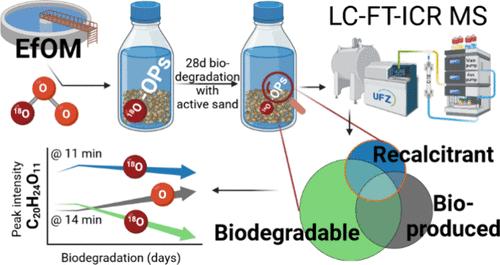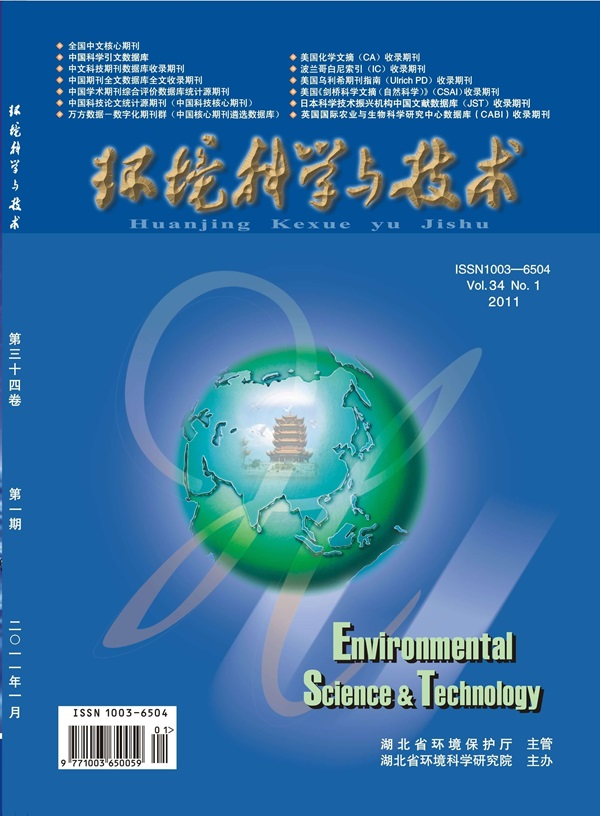Molecular-Level Insights into Recalcitrant Ozonation Products from Effluent Organic Matter
IF 11.3
1区 环境科学与生态学
Q1 ENGINEERING, ENVIRONMENTAL
引用次数: 0
Abstract
Wastewater ozonation is commonly employed to enhance the subsequent biodegradation of effluent organic matter (EfOM) and contaminants of concern. However, there is evidence suggesting the formation of recalcitrant ozonation products (OPs) from EfOM. To investigate the biodegradability of OPs we conducted batch biodegradation experiments using wastewater effluent ozonated with mass-labeled (18O) ozone. Molecular level analysis of EfOM was performed using reversed-phase liquid chromatography coupled with Fourier transform ion cyclotron resonance mass spectrometry (LC-FT-ICR MS) after 3 and 28 days in batch bioreactors. The use of mass labeling allowed for the unambiguous detection of OPs, with 2933 labeled OP features identified in the ozonated EfOM. Furthermore, employing polarity separation with LC facilitated the investigation of reactivity among different OP isomers. Overall, OPs exhibited a comparable proportion of recalcitrant and bioproduced molecular formulas when compared to the remaining EfOM, with 12% of OPs classified as recalcitrant and 17% bioproduced, indicating that OPs themselves are not inherently biodegradable. Additionally, recalcitrant OPs were found to be more polar based on the O/C ratios and retention time, in comparison to biodegradable OPs. Approximately one-third of the OP isomers displayed variations in their biodegradability, suggesting that studying the degradability of ozonated EfOM at the molecular formula level is heavily influenced by structural differences. Here, we offer unique insight into the biological transformation of EfOM after ozonation using labeled ozone and LC-FT-ICR MS analysis.

分子水平上对废水中有机物的顽固性臭氧化产物的见解
废水臭氧化通常用于加强废水有机物(EfOM)和相关污染物的后续生物降解。然而,有证据表明,EfOM形成顽固性臭氧化产物(OPs)。为了研究OPs的生物降解性,我们采用质量标记(18O)臭氧氧化废水进行了批量生物降解实验。在间歇生物反应器中放置3和28天后,采用反相液相色谱联用傅里叶变换离子回旋共振质谱(LC-FT-ICR MS)对EfOM进行分子水平分析。使用质量标记可以明确检测OPs,在臭氧化EfOM中鉴定出2933个标记的OP特征。此外,用液相色谱进行极性分离有助于研究不同OP异构体之间的反应性。总的来说,与剩余的EfOM相比,OPs表现出相当比例的顽固性和生物产生的分子式,其中12%的OPs被归类为顽固性,17%的OPs被归类为生物产生,这表明OPs本身并不是生物降解的。此外,与可生物降解的OPs相比,基于O/C比和保留时间,发现顽固性OPs更具极性。大约三分之一的OP异构体表现出生物降解性的差异,这表明在分子式水平上研究臭氧化EfOM的降解性受到结构差异的严重影响。在这里,我们使用标记臭氧和LC-FT-ICR质谱分析对臭氧化后EfOM的生物转化提供了独特的见解。
本文章由计算机程序翻译,如有差异,请以英文原文为准。
求助全文
约1分钟内获得全文
求助全文
来源期刊

环境科学与技术
环境科学-工程:环境
CiteScore
17.50
自引率
9.60%
发文量
12359
审稿时长
2.8 months
期刊介绍:
Environmental Science & Technology (ES&T) is a co-sponsored academic and technical magazine by the Hubei Provincial Environmental Protection Bureau and the Hubei Provincial Academy of Environmental Sciences.
Environmental Science & Technology (ES&T) holds the status of Chinese core journals, scientific papers source journals of China, Chinese Science Citation Database source journals, and Chinese Academic Journal Comprehensive Evaluation Database source journals. This publication focuses on the academic field of environmental protection, featuring articles related to environmental protection and technical advancements.
 求助内容:
求助内容: 应助结果提醒方式:
应助结果提醒方式:


